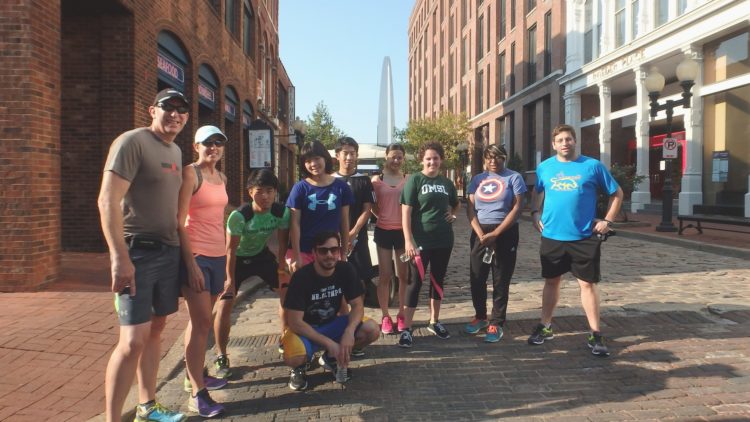On the east end of Kiener Plaza, regal for its vanguard position in the front yard of the Old Courthouse and the Gateway Arch, “The Runner” statue pays tribute to the 1904 Olympic Games held in St. Louis. It also, fittingly, designates the meeting point for the city’s first “sightrunning” tour.
St. Louis Running Tour, launched by Joe Michaelree in 2014, thrust St. Louis into the ranks of American (and European) cities to combine fitness and tourism. Michaelree spent almost a year researching running tours across the country before he started his own business, which he modeled after the Freedom Trail Run in Boston.
With a clipboard in hand, a hydration pack strapped across his shoulders and an iconic backdrop, Michaelree looks every part the fusion of a distance runner and tour guide as he waits for the group to arrive. There are five of us today: three locals and two out-of-towners. Michaelree says it’s not unusual to have a mix of native St. Louisans and visitors.
The assembly arrives a few minutes before the scheduled start time, bedecked in an assortment of running gear that alludes to a wide range of experience, from seasoned distance runner to reluctant gym member. Michaelree initiates introductions: “What’s your name? Where are you from? Are you all comfortable running this distance?”
The last question generally occasions dithering from a tourist or two. Concerns about pace and keeping up with the pack surface. One of our group’s members confesses that she is, in truth, not a runner at all. “We run the pace of the slowest runner,” he assures us. “And sometimes I’m the slowest, and sometimes I’m not. But no one gets left behind.”
Michaelree’s pre-run liturgy is filled with anecdotal quips and self-deprecating humor. He previews the route and points out significant stops along the way. He also sketches a brief history of St. Louis, clarifying that the course we will be taking is not chronological.
“There’s a lot of stopping,” he says. “If you’re looking for speedwork, this probably isn’t for you.”
Our run begins as we cross Broadway and make our first stop in front of the Old Courthouse. Michaelree recounts the details of the notorious Dred Scott trial, which took place in the building. We climb the stairs and even manage a quick walk-through of the exhibits, including the room where the trial was held. As we move through the building — walking, of course, at this point — Michaelree motions towards a circle on the floor in the Rotunda.
“Say something,” he instructs.
I step forward. “This,” I begin before pausing, startled by the vigorous amplification of my voice, “this — oh, my gosh — is amazing! It’s like a microphone!”
I laugh and step aside as the others take turns.
“Can you imagine giving a speech here?” he asks.
We emerge from the other side of the courthouse and make our way toward the Missouri Athletic Club. Michaelree reveals the connection between the MAC, Al Capone and Eddie O’Hare — yes, the Chicago airport guy. We pass the Security Building, where Charles Lindbergh’s flight across the Atlantic was financed, and head down to the riverfront, a distance just shy of a half mile. This is one of the longer non-stop slices of the run.
Construction on the Arch grounds occasions a circuitous route. Once we arrive, Michaelree delivers a meticulous account of the founding and development of the city and its dependence on the Mississippi River. After about 20 minutes, we scramble back up the stairs and head toward our next stop at the Old Cathedral. From there, we zigzag to 4th Street and glance at the TUMS sign down the way.
“Every single TUMS in the world is made right there on 4th,” Michaelree says. Even the native St. Louisans are surprised by this.
We approach Busch Stadium and dive into Ballpark Village, where Michaelree stops to snap a few photos of the group in front of the illustrated outfield on the exterior wall of the new building. Then it’s down Market and through the Gateway Mall. We make stops at various historical, cultural and artistic monuments, some of which are undoubtedly obscure to even an astute local historian.
The tour crests the two-hour mark by the time we reach Union Station. Our group ducks in, some to check out the Whispering Arch, others to use the bathroom. The original route led us down Washington Avenue before making the final turn for Kiener Plaza, but previous engagements prompt the group to prune that section of the tour and head back to our cars.
You’d be hard-pressed to find a more concentrated tour of St. Louis history than in one of Michaelree’s sightruns, but if you’re looking for a solid workout to boot, know that sheer logistics mean the miles are peppered with stops. The full tour is approximately 4.5 miles; it can take well over two hours to cover the distance (as it did in our case). If you sign up for the tour, your interest in St. Louis history is paramount to your running prowess.
On the flip side, if you’re a dedicated runner, the pace and frequent stops can be a bit taxing. You may want to consider scheduling a private tour. St. Louis Running Tour offers customized, 3- to 5-mile routes at a selection of locations: Forest Park, Grand Center Theater District, Grant’s Trail, Jefferson Barracks and Creve Coeur Park. Find more information at stlrunningtour.com.
Author: E.G. Willett is local runner and writer
Image: Courtesy of St. Louis Running Tour


Leave A Comment